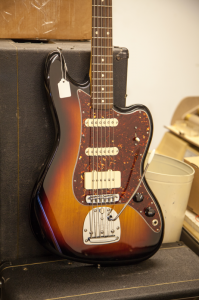In early December I picked up a new guitar from Bob’s Guitars in Cedar Falls. It is a Fender Jaguar Baritone Custom (025-9400-300). This is the second Fender Baritone I’ve owned. I traded a Jaguar Baritone Special HH (025-9300-306) that I also purchased from Bob’s in 2005 on it.
The current Fender Jaguar Baritone models are descendants of the legendary Bass VI that Fender manufactured from 1961-1975. A unique guitar, the Bass VI was inspired by the Danelectro 6-string bass introduced in 1956. Tuned E-e, the Bass VI bridged the gap between an electric bass and an electric guitar. The Bass VI was used notably by Robert Smith of the Cure and Jack Bruce of Cream. Since Cream was the prototype for a Power Trio, Bruce had to play the dual role of rhythm guitar and bass to Clapton’s lead guitar. I became interested in the Bass VI through some interviews I read with Doug McCombs from Tortoise where he talks about the Bass VI and how its distinctive tone impacts his playing. McComb’s side project Brokeback is influenced by and is a showcase of the Bass VI. A bass player myself, I was interested in an intstrument that would allow me to play six-string while taking advantage of my bass background. My bass style is influenced heavily by New Order’s Peter Hook who tended to use the upper registers of the bass for melody. I believe that Hook also played a Bass VI from time-to-time. So, I felt that a Bass VI-style guitar would be up my alley.
I started looking into getting a Bass VI last year, and was disappointed in how much it would cost to get an original vintage Bass VI. Most of them are going for upwards of $3000. In 1995 Fender introduced a 1962 Bass VI reissue. These reissues are going for as much as the originals on eBay. Due to the scarcity of these guitars– they never really took off originally, and I’m sure the 1995 reissues were also not very popular– some Bass VI fans got organized on the Internet and started a campaign to get Fender to bring the VI back.
The petition was successful. In 2004 and 2005 Fender introduced the two Jaguar Baritones currently in production– the Custom and the HH. Further, in 2006 they announced that a 1962 Bass VI reissue would be available from Custom Shop as a Limited Edition available only until 12/31.
In Spring of 2005 I started looking into the new Jaguar-based baritones. I did some calling around and it turned out that Bob’s in Cedar Falls was one of the few stores in the area carrying one. West Music in Cedar Rapids said that they didn’t carry one because they were “speculative” guitars– which I assumed to mean that Fender wasn’t sure if they were going to continue production of these. The model that Bob’s had was the black and chrome HH edition– “HH” means dual humbucking pickups. I visited the store and tried it out with a friend and bought it. I really liked the way it looked and played and it matched my black and white American Precision Bass. The Baritone Custom came in a more traditional sunburst color scheme with a tortoise pickguard.
Unfortunately, there wasn’t enough information available about the Jaguar Baritones when I bought the HH. I had assumed incorrectly that the two Baritones were different only in pickup configuration and color. The Baritone Special HH has a 27″ scale versus the Baritone Custom’s 28.5″ scale. The Special HH tunes to B-B (B, E, A, D, F#, B) whereas the Baritone Custom can be tuned in standard E-E (E, A, D, G, B, E)– just like the Bass VI. The Bass VI has a 30″ scale which allows it to be tuned an octave below a standard guitar. The Baritone Custom uses the same gauge strings as the Bass VI as well. Compare this to a standard Jaguar’s scale of 24″.
My remedial 6-string skills don’t include being able to transpose chords to accomodate the B-B tuning– although all of the chords I know “work.” I could have capoed the guitar for E, too. It wasn’t until this year when I was looking through the Fender catalog that I noticed that Fender had re-named the Baritone Custom as a “Bass VI Custom” and moved the guitar to the bass section. The Bass VI Custom has the same model number as the Baritone Custom did (025-9400-300). This was a smart move on Fender’s part as it drives the point home about the Custom’s Bass VI heritage as well as clear up any confusion about the product. The guitar was debatably incorrectly called a Baritone anyway as it wasn’t tuned to B-B.
When I went to Bob’s in December, they had the Custom with the original “Baritone Custom” labeling instead of the new “Bass VI Custom” labeling. This was only a minor disappointment, really, as the guitar is identical in every other respect. One of the complaints about the original Bass VI was that the tremelo made the guitar knock out of tune easily, so Fender addressed that in this guitar with a fixed bridge. The Baritone HH also has a fixed bridge. I was surprised how much difference the inch and a half makes in playability and tone between the HH and the Custom! While the HH was definately has a low-end growl to it– which is helped a lot with the humbucker pickups– the Custom sounds more like a bass. The string gauge contributes to that as well. The longer neck is a bit disorienting if you are expecting a regular guitar. One of the guys from Bob’s commented on that right away when he was tuning the guitar up for me.
Overall, I’m very pleased with this guitar. It is a bit like braving new territory for me as a guitarist. I’m spending a lot of time figuring out what sounds the best. Like a bass, the Custom sounds best single note playing like surf or western sounding. A lot of barre or power chords sound good in the upper registers of the guitar. I need to figure out what I’m going to do amp-wise. I can tell right now that reverb is a necessity.
Continue reading →





